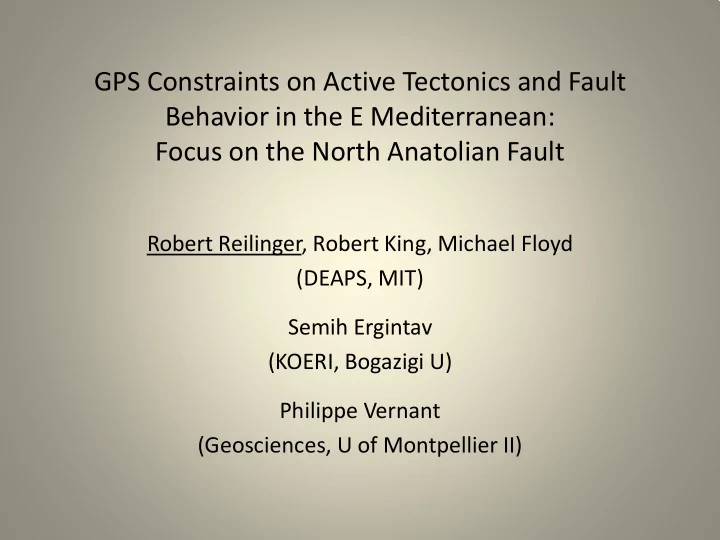

GPS Constraints on Active Tectonics and Fault Behavior in the E Mediterranean: Focus on the North Anatolian Fault Robert Reilinger, Robert King, Michael Floyd (DEAPS, MIT) Semih Ergintav (KOERI, Bogazigi U) Philippe Vernant (Geosciences, U of Montpellier II)
OUTLINE 1-GPS and tectonic framework of E Med 2-Faulting and earthquake hazards (focus on Turkey and E Mediterranean) - Developing simple block models -Strain accumulation on active faults -Locked and creep behavior and relationship to seismicity
1993-2014 GPS sites 915 sGPS sites 372 cGPS sites 723 sigma < 1 mm/yr
GPS Velocities for the AR-AF-EU Plate System (schematic plate bdries from Bird, 2003) EURASIA ARABIA AFRICA
Morocco 09/2015
Crete_2015
Morocco_2015
Regional Kinematics of AR-AF-EU Plate System (schematic plate bdries from Bird, 2003) EURASIA ARABIA AFRICA
Something for every Earth Scientist! Scientific opportunities, but societal hazards EURASIA Continental S-S Fault Continental Collision Subduction ARABIA AFRICA Cont./Ocean Rift
Block models and Earthquakes Faults from MTA, Ankara, 2013
Seismicity and Crustal structure (courtesy of H. Karabulut, KOERI)
A simplified block model (major faults account for ~90% of deformation)
Anatolia fault strain accum. and internal strain of blocks
Anatolia-rigid rotation
Anatolia-fault strain accumulation
Anatolia-rigid rotation Strain accumulation on faults
Locked Faults
Pre-1999 strain accumulation
Postseismic deformation of the 1999 Izmit earthquake between 2003 and 2010 ROI_PAC StaMPS 19/21
20/21 Çakir et al., Geology, 2012
InSAR Fault creep Postseismic creep Fault strain accumulation
UNLOCKED LOCKED More distant sites unlocked, closer sites locked; distance reflects depth on fault
Estimating coupling on the Marmara-Izmit segment 50% or ½ locking depth BUT! 1. Mixing pre and post-eq Fault behavior 2. Need segmented models
NAF Marmara Seismic Gap (Ucarkus, 2010; modified from Armijo et al., 2005) Marmara Seismic Gap (~150 km) Central Marmara segment Izmit segment 1999 M7.6 S. NAF segment
GPS Secular Velocities/Profiles (1994-2013) (from Ergintav et al., GRL, 2014)
Seismicity constraints on fault behavior
General correlation between creep and seismicity (Seismicity courtesy of H. Karabulut, KOERI) Locked Creep Locked
East Anatolian Faults rigid rotation
East Anatolian Fault w/ fault strain accumulation
East Anatolian Fault Seismicity
Caucasus rigid rotation
Caucasus fault strain accumulation
Dead Sea Fault Rigid Fault strain accumulation
Gulf of Corinth-Kefalonia Rigid Fault strain accum
Seismicity in Gulf of Corinth From: Pascal Bernand: http://geo.mff.cuni.cz/seminar/S-140303-Bernard-CRL.pdf
Hellenic Arc plate coupling
Coupling along Hellenic Arc
Hellenic Arc plate coupling
Summary Anatolia and the NAF Very simple elastic block models that include strain accumulation on • active faults account for the large majority of active deformation in Anatolia, and the entire Arabia-Africa-Eurasia zone of plate interactions. The NAF is locked and accumulating strain on the Ganos segment, and • from the E end of the 1999 Izmit Earthquake fault to the Karliova Triple Junction. The Marmara and Izmit Earthquake segments of the NAF are presently • characterized at least in part by fault creep – for the Izmit segment this behavior started after the 1999 M7.4 Earthquake. Continued monitoring and characterizing fault coupling through the • earthquake cycle should provide better estimates of likely eq repeat times along the North Anatolian and other system. Perhaps not surprisingly, fault creep along the NAF and at least for some • other faults (Corinth, EAF, SAF) correlates to first order with seismicity and geology – combining seismicity, geodesy, geology, and laboratory studies holds promise for characterizing better the physics of fault creep.
40/21
Recommend
More recommend